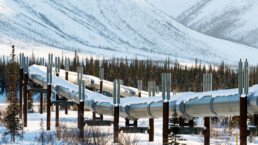Documents obtained by Grist show that Congressional Democrats’ requests for more time to review ConocoPhillips’ Willow Project have been met with silence.
By Adam Federman, Grist
This story was originally published by Grist. You can subscribe to its weekly newsletter here.
For more than four years, ConocoPhillips has been working with the federal government to expand oil and gas development in the National Petroleum Reserve, a roughly 23-million-acre stretch of government-managed land on Alaska’s North Slope. If approved, the so-called Willow Project would allow for construction of up to 250 wells, two airstrips, as well as a network of gravel roads, pipelines, and a new central processing facility in a remote, ecologically sensitive corner of the Arctic.

Willow’s road to approval has been rocky. Last year a federal court ordered the Department of the Interior to redo the project’s legally-required environmental impact statement, or EIS, a new draft of which was released early last month. Now, Congressional Democrats and the Native Village of Nuiqsut, a town of just over 500 people that is closest to the development, are asking the Biden administration for more time to weigh in on the new document.
So far they’ve been met with silence. The Department of the Interior has not responded to formal requests to extend the public comment period on the draft EIS. Two letters obtained by Grist, one from the House Committee on Natural Resources and one from Nuiqsut, described the 45-day comment period — the minimum required by law — as inadequate for a project of this scope. The House committee also requested a response from the Interior Department by July 22 but still has not received an answer.
The Interior Department did not respond to Grist’s formal requests for comment, but an employee who was not authorized to speak on the record told Grist that the requests to extend the comment period are “on everybody’s radar, but no decision has been made.”
Further complicating the administration’s decision is the Democrats’ recent agreement on a reconciliation bill, known as the Inflation Reduction Act, which provides billions in tax credits for renewable energy but also allows for considerable new oil and gas leasing on public lands and in the Gulf of Mexico. The administration may be reluctant to further delay the Willow project as the legislation moves through the narrowly divided Senate.
The project has been described by the Center for American Progress as a “disaster” for the climate that would lock in approximately 260 million metric tons of carbon dioxide emissions over its 30-year lifetime, undermining the Biden administration’s efforts to combat global warming. Willow would also push development closer to a special conservation area around Teshekpuk Lake, the largest body of water in Arctic Alaska and important calving grounds for the Teshekpuk lake caribou herd.
Willow was approved in the final months of the Trump administration, but last summer a federal court found that the department had failed to properly account for the project’s impact on global greenhouse gas emissions, among other issues, and ordered the agency to redo parts of the EIS. The Biden administration, which also defended the original version of project, released its draft supplemental EIS on July 8.
Willow is only about 35 miles from the Native Village of Nuiqsut, which is already surrounded by oil and gas development and has opposed the project. In a June 6 letter to the Bureau of Land Management’s Alaska office, before the draft EIS was released, Nuiqsut Mayor Rosemary Ahtuangaruak noted that a 45-day public comment period would overlap with the busy summer subsistence harvest season, as well as preparation for the fall whale hunt. Ahtuangaruak said that she, along with tribal leadership and the Native village corporation, Kuukpik, requested that the comment period and five public meetings, one of which will be held in Nuiqsut, be extended through the end of September to better accommodate North Slope residents.
Ahtuangaruak told Grist that the Interior Department has been provided with a copy of the community’s subsistence calendar, and that August is one of the busiest times of year. Caribou are beginning to migrate through the region, it is the middle of a short moose hunting season, families are gathering berries and plants, and crews are getting ready to travel to Cross Island to prepare for the whale harvest.
“Either we go out during this time to try to attempt our harvest, or we make a choice to miss out on the harvest and respond to this document,” Ahtuangaruak said. “You can’t be online when you’re out harvesting.”
A July 18 letter from the House Natural Resources Committee echoed Ahtuangaruak’s concerns and described the decision to hold a minimum 45-day comment period during the summer harvest season as “incredibly troubling.” The committee contrasted this with the perception that, under Interior Secretary Deb Haaland, a member of the Pueblo of Laguna who is the first Indigenous cabinet secretary in U.S. history, the department has “begun to restore the principles of transparency, public engagement, and tribal consultation that the previous administration weakened.”
“We ask that you continue to follow through on your commitments to these values as you oversee our public lands by extending the public comment period for the Willow draft [environmental impact statement] by at least 75 days to 120 total days,” the committee wrote. That would take the comment period through the middle of November, almost certainly pushing any final decision into next year.
Pressure to advance the Willow project, however, has been equally strong. During Haaland’s confirmation hearing, Senator Lisa Murkowski, a Republican representing Alaska, described Willow as her top priority and sought assurances that the department would do everything in its power to expedite the project. Haaland made no specific commitments but said she would consult with Murkowski on this issue and “follow the law.”
On July 18, Murkowski issued a press release urging the department to stick to the 45-day public comment period and argued that the project has already undergone extensive review. “Timely completion of this process is critical to the project’s ability to undertake any level of development activities during the rapidly-approaching 2022-2023 winter season,” she wrote.
If Interior does not grant an extension, the public comment period will end on August 29. A final record of decision will be issued sometime after that, potentially giving Conoco enough time to break ground on Willow this winter.
Recent Posts
U.S. Military Willing To Attack “Designated Terrorist Organizations” Within America, General Says
December 19, 2025
Take Action Now “If I had no concerns and I was confident in the lawful order, I would definitely execute that order.”By Nick Turse, The……
DOJ Won’t Meet Friday Deadline To Release All The Epstein Files
December 19, 2025
Take Action Now The delay means the White House is in apparent conflict with a law President Donald Trump signed in November.By Gregory…
Privatize USPS? Mail Carriers Have A Better Idea
December 18, 2025
Take Action Now After battling for a fair contract, USPS workers face the threat of privatization, which they warn will harm all Americans.By Mel…
Senate Passes Massive $901 Billion National Defense Authorization Act, Sending It To Trump’s Desk
December 18, 2025
Take Action Now When combined with a supplemental bill passed earlier this year, the NDAA will bring the US military budget to over $1 trillionBy…




